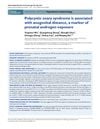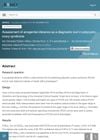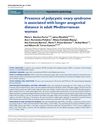Polycystic Ovary Syndrome: Anogenital Distance as a Marker of Prenatal Androgenic Environment and Review and Comparison of Diagnostic Criteria
January 2020
in “
Proyecto de investigación:
”
TLDR Longer anogenital distance may indicate a higher chance of having polycystic ovary syndrome, and measuring this distance along with hormone levels could improve diagnosis.
The document presents findings from a study that explored the relationship between anogenital distance (AGD) and polycystic ovary syndrome (PCOS) in adult Mediterranean women. The study, which involved 300 patients, found that women with PCOS had significantly longer AGD, particularly the distance from the anterior clitoral surface to the upper verge of the anus (AGDAC), compared to controls. Women in the upper tertile for AGDAC were 2.9 times more likely to have PCOS. The study also demonstrated that combining AGDAC measurements with anti-Müllerian hormone (AMH) levels provided greater diagnostic accuracy for PCOS than either measurement alone, with an area under the curve of 0.87 for diagnosing PCOS. These results suggest that AGDAC could be an effective clinical tool for diagnosing PCOS and that the intrauterine hormonal environment may play a significant role in the development of PCOS. The combination of AGDAC and AMH could improve the diagnosis and management of PCOS patients.



